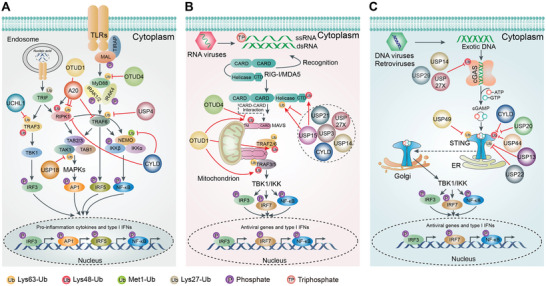Figure 8.

DUBs in innate immune receptor signaling. Innate immunity is activated by signaling cascades associated with pattern recognition receptors (PRRs), including TLRs (A), RLRs (B), and cGAS (C). A) Almost all reported DUBs play a negative regulatory role in TRL signaling, including A20, CYLD, UCHL1, OTUD4, and USP4. These DUBs promote signaling transduction and stabilization of the key mediators in TLR signaling cascades by cleaving the Lys63‐ or Lys48‐linked Ub‐chain from them, such as TRAF6, MyD88, NEMO, TRAF3, and RIP1. This avoids excessive production of pro‐inflammatory cytokines and IFNs. B) Unlike TLR signaling, RLRs can be selectively positively or negatively regulated by DUBs through removal of non‐degradative Lys63‐linked Ub chains or degradative Lys48‐linked Ub chains. CYLD removes Lys63‐linked polyubiquitin chains from RIG‐I, which disrupts the fundamental activation levels and impairs the production of IFN induced by RIG‐I. Additionally, USP3, USP21, USP14, USP27X, and USP15 similarly serve as negative regulators of signaling governed by RIG‐I by removing Lys63‐linked ubiquitination on RIG‐I. However, USP15 also exerts an opposite function through cleaving Lys48‐linked Ub‐chain, which contributes to continuing type I IFN expression. Besides, USP17, USP4, and OTUD4 remove the Lys48‐linked Ub chains from RIG‐I, MDA5, and MAVS, respectively, thereby limiting their proteasomal degradation and facilitating the expression of type I IFN and Antiviral Responses. C) USP14 and USP27X stabilize cGAS by removing the Lys48‐linked Ub‐chain during cGAS‐STING signaling, and promote signaling cascades and type I IFN production. STING can also be stabilized by USP20, CYLD, and USP44 via cleaving Lys48‐linked Ub‐chain. Meanwhile, USP49 removes Lys63‐linked Ub‐chain of STING which leads to decreased interactions between STING and TBK1, and inhibits Antiviral Responses. Moreover, USP13 and USP22 exert a comparable effect on STING and play a negative regulatory role in cGAS‐STING signaling.
